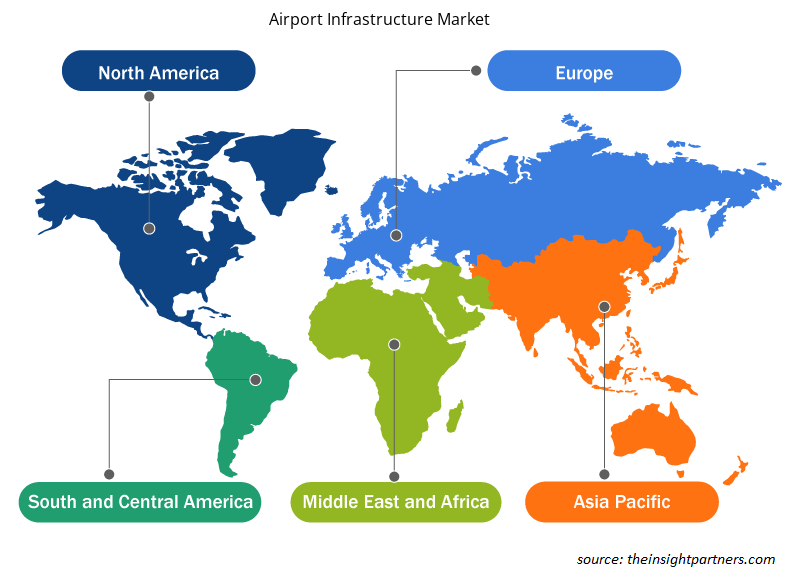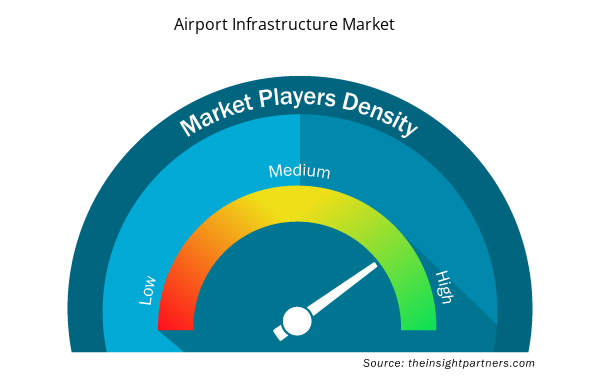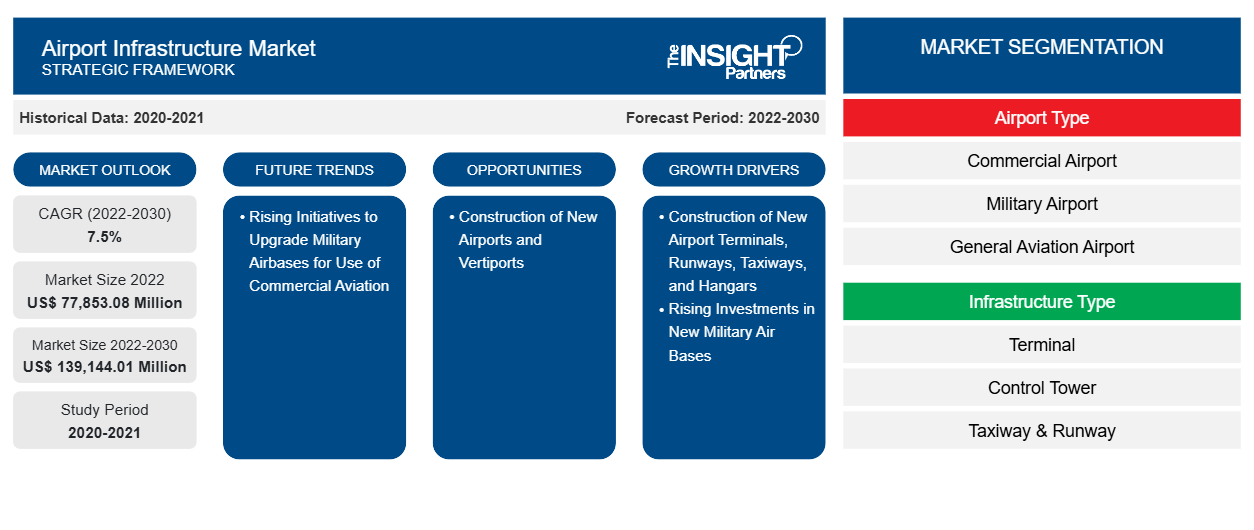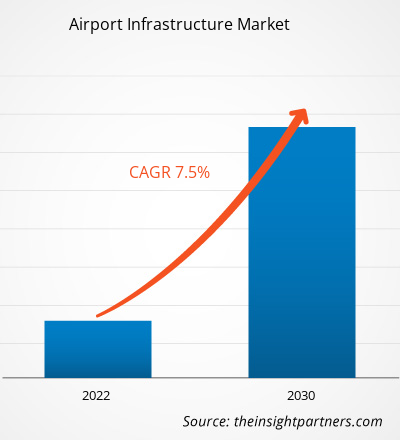空港インフラ市場規模は、2022年の778億5,308万米ドルから2030年には1391億4,401万米ドルに達すると予測されています。市場は2022年から2030年にかけて7.5%のCAGRを記録すると予想されています。各国政府は、増加する航空機群と乗客に対応するために、新しい空港を建設する取り組みを行っています。たとえば、インド政府は2022年に、2025年末までに220の商業空港を建設する計画を発表しました。さらに、2018年には、中国民用航空局(CAAC)が2035年末までに216の新しい空港を建設する計画を発表し、これにより空港の総数は2035年までに450に増加することになります(2023年現在234空港)。このような開発により、世界中の商業空港セグメントの空港インフラ市場の成長が促進されています。
空港インフラ市場分析
さまざまな地域の国々の間で世界的緊張が高まっているため、軍用空港や新しい空軍基地の需要が高まっています。多くの国が、ミッション関連技術の調達や、それぞれの目標地点に新しい基地を建設するために、それぞれの軍事投資を推進しています。さらに、より多くの軍用機に対応するために既存の軍用空港を拡張したことで、世界中の軍用空港セグメントの空港インフラ市場の成長が促進されています。たとえば、2021年9月、中国政府は、チベットと新疆ウイグル自治区に30の新しい空港が建設され、これらの地域の民間および軍用空港インフラが強化されたと発表しました。さらに、以前に発表されたインド軍の59の空港建設計画も進行中です。2023年11月末までに、インドにはそれぞれの運用のために約39の軍用空港がありました。このような開発は、軍用空港セグメントの空港インフラ市場の成長を促進しています。
空港インフラ市場の概要
ゼネラルアビエーション空港は、基本的にビジネスジェット、ピストンエンジン機、ヘリコプター、練習機を対象とし、離着陸、MROサービス、運用チェック、プライベートチャーター運航などの業務を行っています。米国、中国、ロシア、英国などのいくつかの国では、すでに多数のゼネラルアビエーション空港があり、それぞれの地域での空港拡張プロジェクトを通じて、ゼネラルアビエーション空港セグメントの空港インフラ市場の成長を促進しています。たとえば、2023年9月、米国サンフランシスコベイエリアの主要なゼネラルアビエーション空港の1つ(サンカルロス空港)は、50,000平方フィートの新しい格納庫スペースと、さらに22,000平方フィートの共用エリア、オフィススペース、会議室を備えた空港のアップグレードへの投資を発表しました。さらに、2020年には、デリーのインディラガンディー国際空港もビジネスジェット運航用の新しいターミナルを開設しました。こうした発展により、一般航空空港部門の空港インフラ市場の成長が促進されています。
要件に合わせてレポートをカスタマイズする
このレポートの一部、国レベルの分析、Excelデータパックなど、あらゆるレポートを無料でカスタマイズできます。また、スタートアップや大学向けのお得なオファーや割引もご利用いただけます。
- このレポートの主要な市場動向を入手してください。この無料サンプルには、市場動向から見積もりや予測に至るまでのデータ分析が含まれます。
空港インフラ市場の推進要因と機会
新しい空港ターミナル、滑走路、誘導路、格納庫の建設の増加
世界的な商用航空機の増加は、世界中で増加する旅客交通量に対応するために、さまざまな空港で新しいフライト、ターミナル、滑走路、格納庫の需要を生み出す主な要因の1つです。これにより、より多くの航空機に対応できるようにそれぞれの空港施設をアップグレードするための空港当局による投資も促進され、空港全体の運用効率も向上します。これは、世界中の航空旅客交通を支えてきた格安航空会社の導入によっても後押しされています。2023年3月、カナダのケロウナ市議会は、ケロウナ空港ターミナルの拡張プロジェクトに9,000万米ドルの資金提供を承認すると発表しました。さまざまな国のいくつかの政府当局も、国際貨物貿易と航空旅行業界の流れを強化するために、それぞれの国に新しい空港を建設する計画を立てています。たとえば、米国では現在、6つの新しい空港が建設中です。また、インド政府は2022年に、2025年末までに220の空港を建設する計画を発表しました。さらに、2018年には、中国民用航空局(CAAC)が2035年末までに216の新しい空港を建設する計画を発表しており、2035年までに空港の総数は450空港に増加する見込みです(2023年現在234空港)。このように、新しい空港ターミナル、滑走路、誘導路、格納庫の建設は、世界中の空港インフラ市場の成長に貢献しています。
民間航空の利用のために軍用飛行場をアップグレードする取り組みが増加
いくつかの国の政府は、新しい商業空港が運用されるまで、さまざまな地域で増加する乗客交通を管理するための利便性を高めるために、それぞれの軍用空港を商業航空機の着陸と運用に許可する取り組みを行っています。他のいくつかの取り組みには、選択的な軍用空港をハイブリッド空港にアップグレードすることが含まれます。たとえば、AFプラント42(カリフォルニア州パームデール)、バーターアイランドLRRS(バーターアイランド)、AKチャールストン空軍基地(サウスカロライナ州チャールストン)、ドーバー空軍基地(デラウェア州ドーバー)、エグリン空軍基地(フロリダ州バルパライソ)、グリソム空軍基地(インディアナ州ペルー)、ケリー/ラックランド空軍基地(テキサス州)など、米国のいくつかの軍用空港では、民間スポンサーが着陸または離陸操作に軍用飛行場を使用したい場合、これらの既存の軍用空港の共同使用が許可されています。したがって、商業航空の使用のために軍用飛行場をアップグレードする取り組みの増加は、予測期間中に空港インフラ市場の成長を促進すると予想されます。
空港インフラ市場レポートのセグメンテーション分析
空港インフラ市場分析の導出に貢献した主要なセグメントは、空港の種類、インフラの種類、および地理です。
- 空港の種類に基づいて、空港インフラ市場は商業空港、軍用空港、一般航空空港に分類されています。商業空港セグメントは2022年に大きな市場シェアを占めました。
- インフラの種類別に見ると、空港インフラ市場はターミナル、管制塔、誘導路と滑走路、格納庫、その他に分類されています。ターミナルセグメントは2022年に市場で最大のシェアを占めました。
空港インフラ市場シェアの地域別分析
空港インフラ市場レポートの地理的範囲は、主に北米、ヨーロッパ、アジア太平洋、中東およびアフリカ、南米の 5 つの地域に分かれています。
アジア太平洋地域は2022年に空港インフラ市場を支配しており、予測期間中もその支配を維持すると予想されています。また、アジア太平洋地域は、2022年から2030年の間に空港インフラ市場で最高のCAGRを記録する可能性があります。これは、この地域の空港施設の拡張と近代化への投資の増加によるものです。さらに、アジア太平洋地域は、地域の堅調な経済成長と航空旅行の急増に牽引され、空港インフラ開発のダイナミックなハブとしての地位を確立しています。中国やインドなどの国では、新しい空港の建設と拡張プロジェクトへの大規模な投資が行われています。これらの取り組みは、増加する乗客数に対応し、地域の接続性を促進することを目的としています。
空港インフラ市場の地域別洞察
予測期間を通じて空港インフラ市場に影響を与える地域的な傾向と要因は、Insight Partners のアナリストによって徹底的に説明されています。このセクションでは、北米、ヨーロッパ、アジア太平洋、中東およびアフリカ、南米および中米にわたる空港インフラ市場のセグメントと地理についても説明します。

- 空港インフラ市場の地域別データを入手
空港インフラ市場レポートの範囲
| レポート属性 | 詳細 |
|---|---|
| 2022年の市場規模 | 77,853.08百万米ドル |
| 2030年までの市場規模 | 139,144.01百万米ドル |
| 世界のCAGR(2022-2030年) | 7.5% |
| 履歴データ | 2020-2021 |
| 予測期間 | 2022-2030 |
| 対象セグメント | 空港タイプ別
|
| 対象地域と国 | 北米
|
| 市場リーダーと主要企業プロフィール |
|
空港インフラ市場のプレーヤー密度:ビジネスダイナミクスへの影響を理解する
空港インフラ市場は、消費者の嗜好の変化、技術の進歩、製品の利点に対する認識の高まりなどの要因により、エンドユーザーの需要が高まり、急速に成長しています。需要が高まるにつれて、企業は提供内容を拡大し、消費者のニーズを満たすために革新し、新たなトレンドを活用し、それが市場の成長をさらに促進しています。
市場プレーヤー密度とは、特定の市場または業界内で活動している企業または会社の分布を指します。これは、特定の市場スペースに、その市場規模または総市場価値に対してどれだけの競合相手 (市場プレーヤー) が存在するかを示します。
空港インフラ市場で事業を展開している主要企業は次のとおりです。
- ヘンゼル・フェルプス
- AECOM
- ターナー建設会社
- スカンスカ
- オースティン インダストリーズ
免責事項:上記の企業は、特定の順序でランク付けされていません。

- 空港インフラ市場のトップキープレーヤーの概要を入手
空港インフラ市場のニュースと最近の動向
空港インフラ市場は、主要な企業出版物、協会データ、データベースを含む一次調査と二次調査後の定性的および定量的データを収集することによって評価されます。以下は、空港インフラ市場の市場動向と戦略のリストです。
- ヘンゼル フェルプスは、2023 年にコロンバス地域空港局 (CRAA) からジョン グレン コロンバス国際空港の新ターミナル プロジェクトのリスク管理担当 (CMaR) に任命されました。このプロジェクトでは、ヘンゼル フェルプス | エルフォード チームが建設前サービスと建設サービスを提供します。このプロジェクトにより、ヘンゼル フェルプスはオハイオ市場に参入し、CRAA およびエルフォードとのパートナーシップを強化します。(出典: ヘンゼル フェルプス、プレス リリース/会社 Web サイト/ニュースレター)
- 2022年、AECOMはHJラッセル&カンパニーとの合弁会社であるエアフィールド・マネジメント・パートナーズが、ダラス・フォートワース国際空港の民間エアサイドプログラムおよび建設管理サービスを提供するために選定されたと発表しました。(出典:AECOM、プレスリリース/企業ウェブサイト/ニュースレター)
空港インフラ市場レポートの対象範囲と成果物
「空港インフラ市場の規模と予測(2020〜2030年)」レポートでは、以下の分野をカバーする市場の詳細な分析を提供しています。
- 対象範囲に含まれるすべての主要市場セグメントの世界、地域、国レベルでの市場規模と予測
- 市場の動向(推進要因、制約、主要な機会など)
- 今後の主な動向
- ポーターのファイブフォース分析の詳細
- 主要な市場動向、主要プレーヤー、規制、最近の市場動向を網羅した世界および地域の市場分析
- 市場集中、ヒートマップ分析、主要プレーヤー、最近の動向を網羅した業界の状況と競争分析
- SWOT分析による詳細な企業プロフィール
- 過去2年間の分析、基準年、CAGRによる予測(7年間)
- PEST分析とSWOT分析
- 市場規模価値/数量 - 世界、地域、国
- 業界と競争環境
- Excel データセット



Report Coverage
Revenue forecast, Company Analysis, Industry landscape, Growth factors, and Trends

Segment Covered
This text is related
to segments covered.

Regional Scope
North America, Europe, Asia Pacific, Middle East & Africa, South & Central America

Country Scope
This text is related
to country scope.
Trends and growth analysis reports related to Aerospace and Defense : READ MORE..
The Insight Partners performs research in 4 major stages: Data Collection & Secondary Research, Primary Research, Data Analysis and Data Triangulation & Final Review.
- Data Collection and Secondary Research:
As a market research and consulting firm operating from a decade, we have published and advised several client across the globe. First step for any study will start with an assessment of currently available data and insights from existing reports. Further, historical and current market information is collected from Investor Presentations, Annual Reports, SEC Filings, etc., and other information related to company’s performance and market positioning are gathered from Paid Databases (Factiva, Hoovers, and Reuters) and various other publications available in public domain.
Several associations trade associates, technical forums, institutes, societies and organization are accessed to gain technical as well as market related insights through their publications such as research papers, blogs and press releases related to the studies are referred to get cues about the market. Further, white papers, journals, magazines, and other news articles published in last 3 years are scrutinized and analyzed to understand the current market trends.
- Primary Research:
The primarily interview analysis comprise of data obtained from industry participants interview and answers to survey questions gathered by in-house primary team.
For primary research, interviews are conducted with industry experts/CEOs/Marketing Managers/VPs/Subject Matter Experts from both demand and supply side to get a 360-degree view of the market. The primary team conducts several interviews based on the complexity of the markets to understand the various market trends and dynamics which makes research more credible and precise.
A typical research interview fulfils the following functions:
- Provides first-hand information on the market size, market trends, growth trends, competitive landscape, and outlook
- Validates and strengthens in-house secondary research findings
- Develops the analysis team’s expertise and market understanding
Primary research involves email interactions and telephone interviews for each market, category, segment, and sub-segment across geographies. The participants who typically take part in such a process include, but are not limited to:
- Industry participants: VPs, business development managers, market intelligence managers and national sales managers
- Outside experts: Valuation experts, research analysts and key opinion leaders specializing in the electronics and semiconductor industry.
Below is the breakup of our primary respondents by company, designation, and region:

Once we receive the confirmation from primary research sources or primary respondents, we finalize the base year market estimation and forecast the data as per the macroeconomic and microeconomic factors assessed during data collection.
- Data Analysis:
Once data is validated through both secondary as well as primary respondents, we finalize the market estimations by hypothesis formulation and factor analysis at regional and country level.
- Macro-Economic Factor Analysis:
We analyse macroeconomic indicators such the gross domestic product (GDP), increase in the demand for goods and services across industries, technological advancement, regional economic growth, governmental policies, the influence of COVID-19, PEST analysis, and other aspects. This analysis aids in setting benchmarks for various nations/regions and approximating market splits. Additionally, the general trend of the aforementioned components aid in determining the market's development possibilities.
- Country Level Data:
Various factors that are especially aligned to the country are taken into account to determine the market size for a certain area and country, including the presence of vendors, such as headquarters and offices, the country's GDP, demand patterns, and industry growth. To comprehend the market dynamics for the nation, a number of growth variables, inhibitors, application areas, and current market trends are researched. The aforementioned elements aid in determining the country's overall market's growth potential.
- Company Profile:
The “Table of Contents” is formulated by listing and analyzing more than 25 - 30 companies operating in the market ecosystem across geographies. However, we profile only 10 companies as a standard practice in our syndicate reports. These 10 companies comprise leading, emerging, and regional players. Nonetheless, our analysis is not restricted to the 10 listed companies, we also analyze other companies present in the market to develop a holistic view and understand the prevailing trends. The “Company Profiles” section in the report covers key facts, business description, products & services, financial information, SWOT analysis, and key developments. The financial information presented is extracted from the annual reports and official documents of the publicly listed companies. Upon collecting the information for the sections of respective companies, we verify them via various primary sources and then compile the data in respective company profiles. The company level information helps us in deriving the base number as well as in forecasting the market size.
- Developing Base Number:
Aggregation of sales statistics (2020-2022) and macro-economic factor, and other secondary and primary research insights are utilized to arrive at base number and related market shares for 2022. The data gaps are identified in this step and relevant market data is analyzed, collected from paid primary interviews or databases. On finalizing the base year market size, forecasts are developed on the basis of macro-economic, industry and market growth factors and company level analysis.
- Data Triangulation and Final Review:
The market findings and base year market size calculations are validated from supply as well as demand side. Demand side validations are based on macro-economic factor analysis and benchmarks for respective regions and countries. In case of supply side validations, revenues of major companies are estimated (in case not available) based on industry benchmark, approximate number of employees, product portfolio, and primary interviews revenues are gathered. Further revenue from target product/service segment is assessed to avoid overshooting of market statistics. In case of heavy deviations between supply and demand side values, all thes steps are repeated to achieve synchronization.
We follow an iterative model, wherein we share our research findings with Subject Matter Experts (SME’s) and Key Opinion Leaders (KOLs) until consensus view of the market is not formulated – this model negates any drastic deviation in the opinions of experts. Only validated and universally acceptable research findings are quoted in our reports.
We have important check points that we use to validate our research findings – which we call – data triangulation, where we validate the information, we generate from secondary sources with primary interviews and then we re-validate with our internal data bases and Subject matter experts. This comprehensive model enables us to deliver high quality, reliable data in shortest possible time.


 このレポートの無料サンプルを入手する
このレポートの無料サンプルを入手する